12 Best Blogging Sites for Free in 2025: A Deep Dive
- Sep 10
- 15 min read
Starting a blog is a powerful way to share your ideas, build a community, or monetize your passion. But you don't need a big budget to get started. The internet is filled with incredible blogging sites for free that offer robust features without costing a dime. This guide moves beyond simple feature lists to give you the practical insights, honest limitations, and clear use cases you need to make the right choice. We'll explore 12 of the best platforms available today, each with detailed analysis, screenshots, and direct links to help you get started immediately.
Whether you're a writer building a portfolio, a developer sharing technical knowledge, or a gamer detailing winning strategies, this breakdown will help you choose the perfect free home for your content. We analyze each option, from the all-around power of WordPress.com to the minimalist appeal of Substack and the developer-centric focus of Hashnode. For those diving into blogging, exploring the best AI tools for content creators can also significantly boost your creativity and productivity. Our goal is to equip you with the information needed to confidently select a platform that aligns with your specific goals, ensuring you can start sharing your voice with the world right away.
1. WordPress.com
WordPress.com is arguably the most recognizable name in blogging, offering one of the best free platforms for those just starting out. It provides a powerful, hosted solution that handles all the technical aspects like security, hosting, and updates, allowing you to focus purely on content creation. The free plan is robust, giving you a subdomain, a built-in SSL certificate for security, and access to dozens of professional themes to customize your site's look and feel.
The platform stands out due to its scalability. You can begin with a completely free blog and seamlessly upgrade to paid plans as your audience grows, unlocking features like custom domains, advanced design tools, and the ability to monetize. For new creators looking for reliable blogging sites for free, WordPress.com’s combination of a user-friendly editor and a clear growth path is hard to beat. If you want a more detailed breakdown, you can learn more about how WordPress.com stacks up against other options.
Key Details & Limitations
Best For: New bloggers, writers, and hobbyists who want a simple start with a powerful, scalable platform.
User Experience: The block editor (Gutenberg) is intuitive, making it easy to create visually appealing posts without coding knowledge.
Pros: Reliable and secure hosting, huge support community, and a clear upgrade path.
Cons: The free plan includes WordPress.com ads on your site, and you cannot install custom plugins or use a custom domain without upgrading.
Website: https://wordpress.com
2. Blogger (Blogspot)
Blogger is Google’s time-tested, straightforward blogging platform, offering one of the simplest entry points into the world of content creation. It is completely free and provides a reliable, no-frills experience with free hosting and a subdomain. Because it’s a Google product, it integrates seamlessly with other services like Google Analytics for tracking traffic and AdSense for potential monetization, making it a practical choice for beginners.
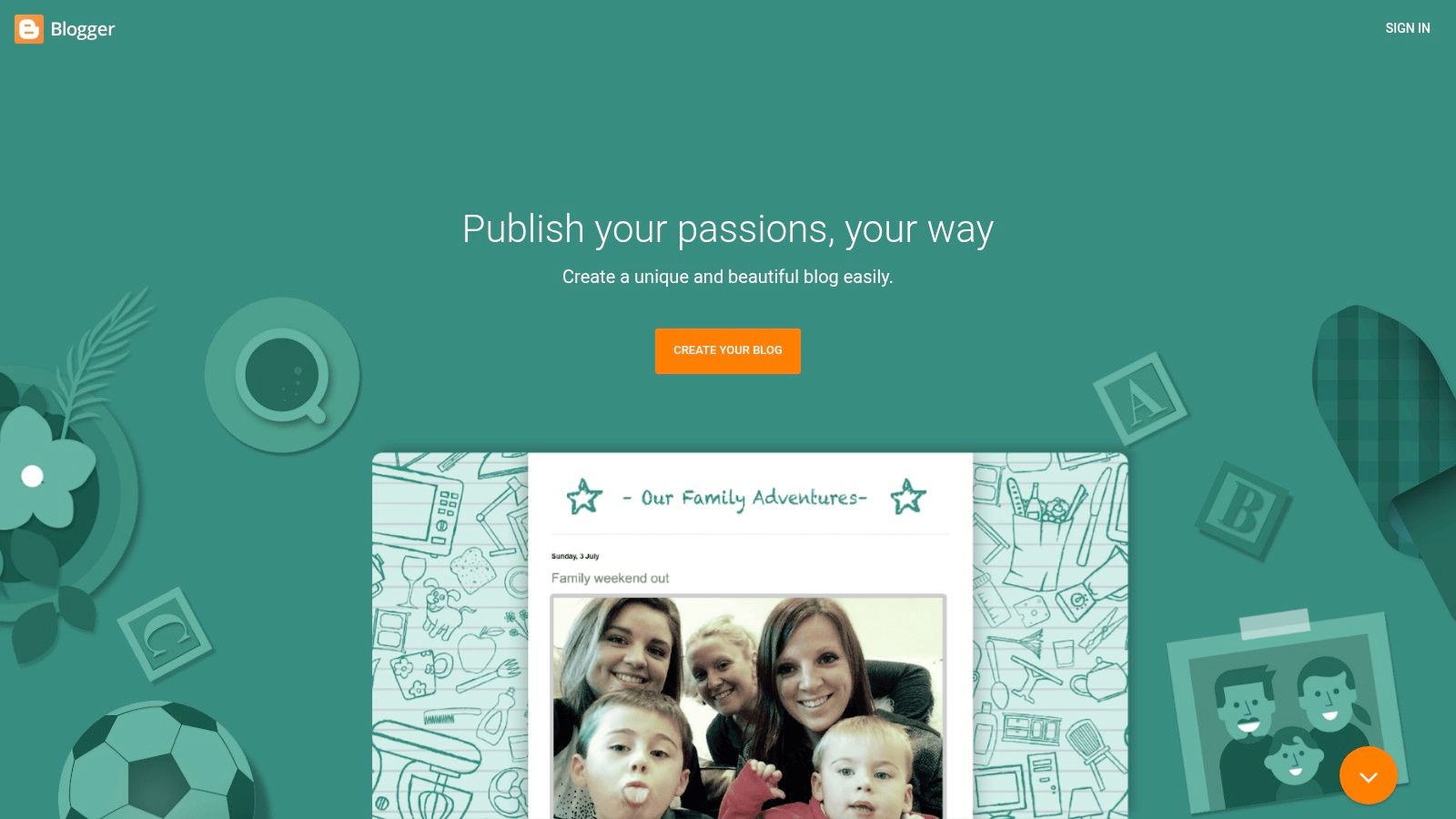
The platform stands out for its absolute simplicity and zero cost. Unlike many other blogging sites for free, Blogger has no paid upgrades, traffic limits, or hidden fees. You can even connect a custom domain for free, a feature that often requires a paid plan elsewhere. For writers who want a dependable space to publish their thoughts without worrying about hosting, maintenance, or complex setups, Blogger remains a powerful and accessible option.
Key Details & Limitations
Best For: Hobbyist bloggers, personal journal writers, and anyone who wants an incredibly simple and completely free platform with minimal setup.
User Experience: The interface is very basic and intuitive, making it easy to write and publish posts within minutes of signing up.
Pros: Absolutely free with no upsells, excellent reliability and uptime backed by Google, and easy integration with Google services.
Cons: Limited design customization, outdated themes, and a minimal feature set that lacks the advanced functionality of modern platforms.
Website: https://www.blogger.com
3. Wix
Wix is a highly popular drag-and-drop website builder that offers a powerful and visually-driven approach to blogging. Its free plan provides everything needed to launch a stylish blog, including a subdomain, free hosting, and access to a vast library of professionally designed templates. The platform is especially appealing to those who prioritize aesthetics and want granular control over their site's layout without touching a single line of code.
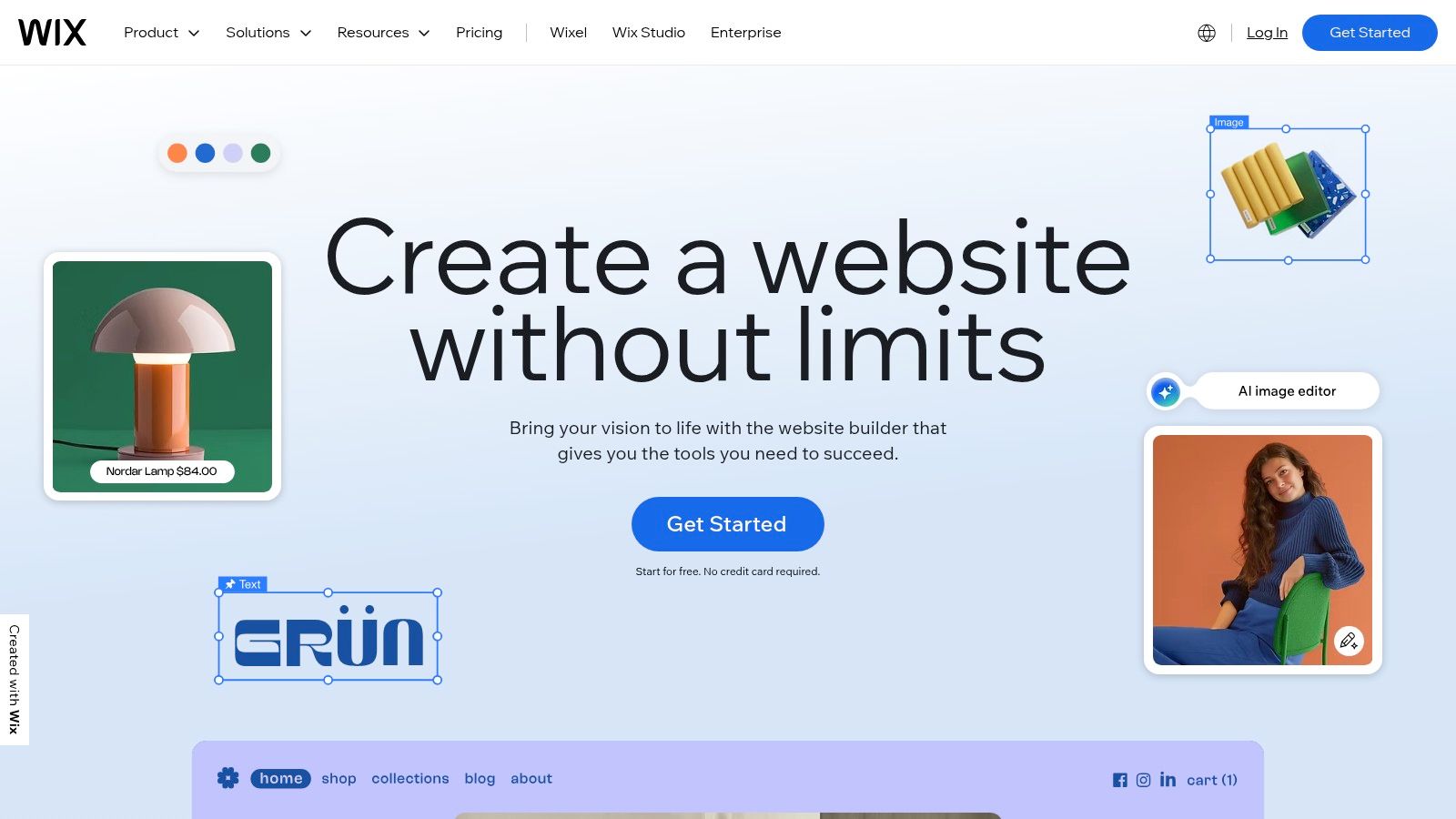
What makes Wix stand out among other blogging sites for free is its integration of AI tools, such as an AI post generator and SEO assistants, which help streamline content creation and optimization. This makes it an excellent choice for creators who want built-in support to produce and rank content more efficiently. As your blog grows, you can easily upgrade to unlock a custom domain, remove Wix branding, and access advanced marketing features.
Key Details & Limitations
Best For: Visual creators, small businesses, and bloggers who want maximum design freedom without coding.
User Experience: The drag-and-drop editor is exceptionally intuitive, offering a true "what you see is what you get" (WYSIWYG) experience.
Pros: Highly flexible design editor, polished modern templates, and helpful built-in AI and SEO tools.
Cons: The free plan includes prominent Wix branding and ads, and you cannot switch templates after your site is live.
Website: https://www.wix.com
4. Weebly (by Square)
Weebly, now part of the Square ecosystem, is a fantastic choice for those who want an incredibly simple, visual approach to building a blog. It’s known for its powerful drag-and-drop editor, which allows you to construct your site layout exactly how you envision it without touching a single line of code. The free plan provides you with a subdomain, a free SSL certificate for security, and basic SEO tools to help your content get discovered, making it one of the most accessible blogging sites for free.

The platform truly shines for users who anticipate eventually adding an online store or other e-commerce functionalities. Because of its integration with Square, transitioning from a simple blog to a full-fledged business website is a smooth process. Even on the free plan, the interface is clean and uncluttered, prioritizing ease of use above all else. This makes it an ideal starting point for anyone who feels intimidated by more complex platforms but still wants a professional-looking result with a clear path for future growth.
Key Details & Limitations
Best For: Beginners, small business owners, and creators who want a simple blog with the potential to add e-commerce features later.
User Experience: The drag-and-drop interface is one of the most intuitive on the market, making site and post creation extremely fast and easy.
Pros: Very easy to learn and set up, low-cost upgrade options, and strong e-commerce integration through Square.
Cons: The free plan has limited templates and design flexibility, and you must upgrade to use a custom domain or remove Weebly branding.
Website: https://www.weebly.com
5. Medium
Medium is less of a traditional blogging platform and more of a publishing network where writing takes center stage. It offers one of the cleanest, most distraction-free experiences among blogging sites for free, stripping away complex design choices so you can focus entirely on your words. The platform provides a simple, elegant editor and allows anyone to publish articles that can be discovered by its large, built-in audience through a system of tags and publications.
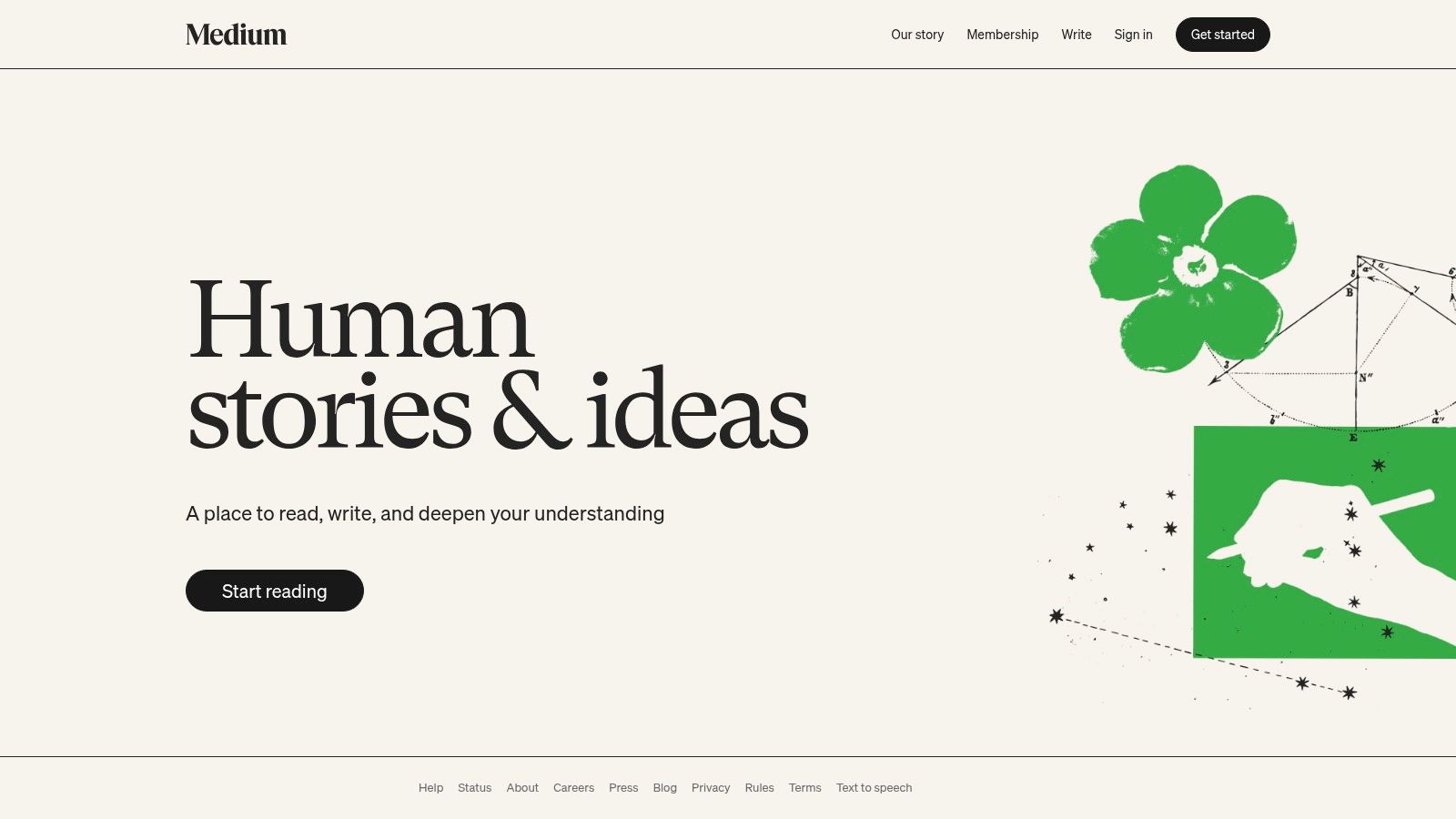
What makes Medium stand out is its social component and built-in monetization potential. Your content has the chance to be seen by millions without any marketing effort, and you can join the Medium Partner Program to earn money based on member engagement. It’s an ideal choice for writers who prioritize content quality and audience reach over brand customization. For a deeper look, you can explore more about Medium and its unique features.
Key Details & Limitations
Best For: Thought leaders, journalists, and expert writers who want to reach a pre-existing audience without worrying about site management.
User Experience: Incredibly simple and intuitive. The what-you-see-is-what-you-get editor is praised for its minimalist design.
Pros: Access to a large, engaged readership, a beautiful and clean reading interface, and the potential to earn money through the Partner Program.
Cons: Very limited branding and design customization. Your content is also on Medium's platform, and some articles may be placed behind a reader paywall.
Website: https://medium.com
6. Substack
Substack redefines the traditional blog by merging it with a powerful newsletter platform. It's a fantastic choice for writers who want to build a direct relationship with their audience by delivering content straight to their inbox. The platform is completely free to publish on, giving you a custom URL, an online archive of all your posts, and integrated email delivery. This hybrid approach makes it one of the most unique and effective blogging sites for free available today.
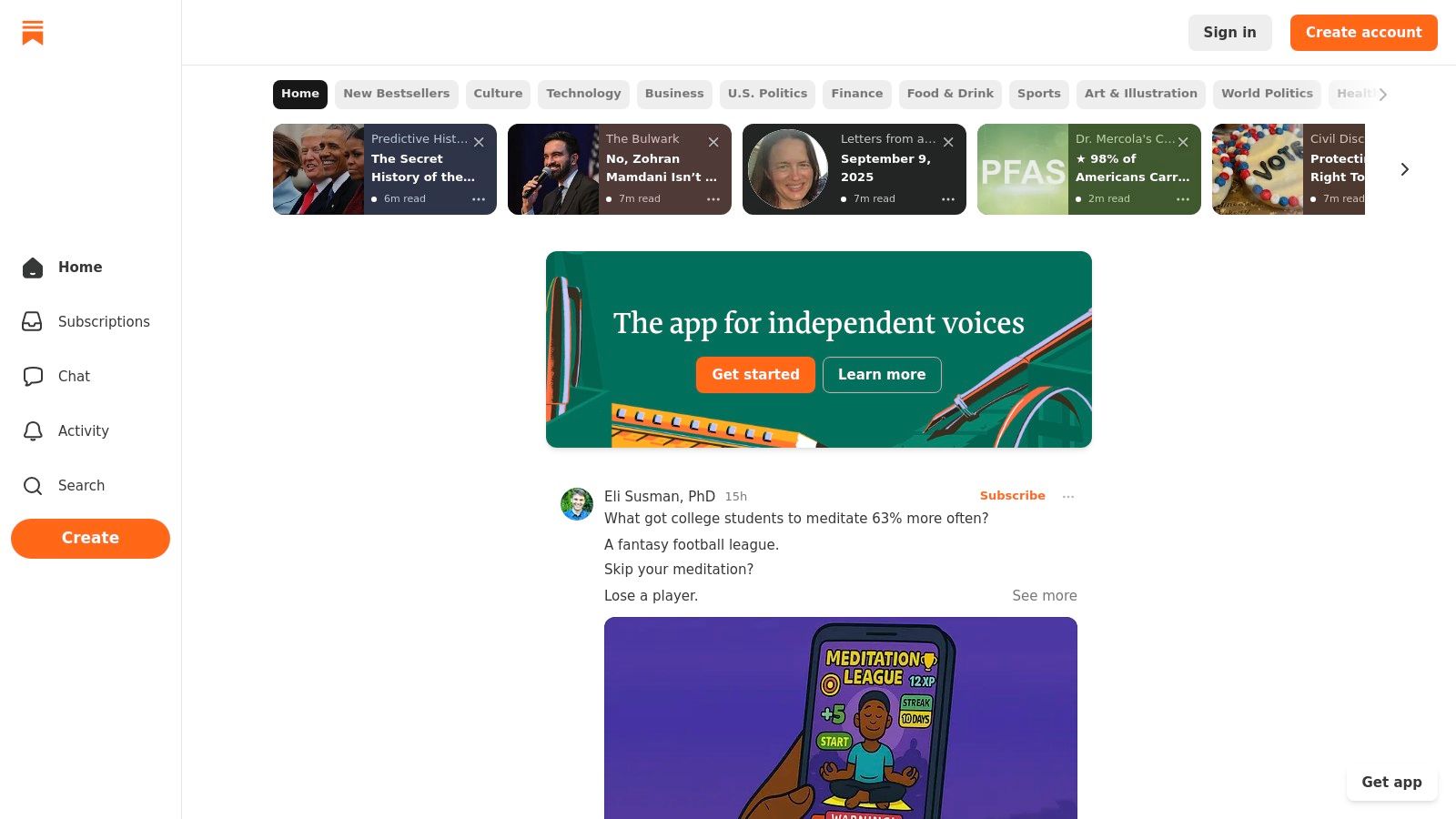
The platform’s standout feature is its built-in monetization model. While publishing is free, you can easily enable paid subscriptions at any time, allowing loyal readers to support your work directly. Substack handles the payment processing and takes a 10% cut, but only from paying subscribers. This simple, direct-to-creator monetization is perfect for writers, journalists, and experts who aim to build a dedicated community and generate revenue without the complexities of ads or affiliate marketing.
Key Details & Limitations
Best For: Writers, journalists, and subject-matter experts focused on building a loyal, email-based audience.
User Experience: The editor is minimalist and text-focused, prioritizing a clean writing and reading experience over complex design.
Pros: Seamless integration of blog and newsletter, direct-to-inbox reader relationships, and a straightforward, built-in monetization system.
Cons: Very limited design customization, basic analytics, and you cannot use a custom domain on the free plan.
Website: https://substack.com
7. Tumblr
Tumblr carves out a unique niche among blogging sites for free by blending traditional blogging with the fast-paced, visual nature of social media. It excels as a platform for expression, allowing users to easily share a wide variety of content, including text, photos, GIFs, audio, and video. The free plan provides you with a customizable blog, access to a vast library of themes, and powerful social features like reblogging and following, which help your content get discovered organically within its vibrant community.
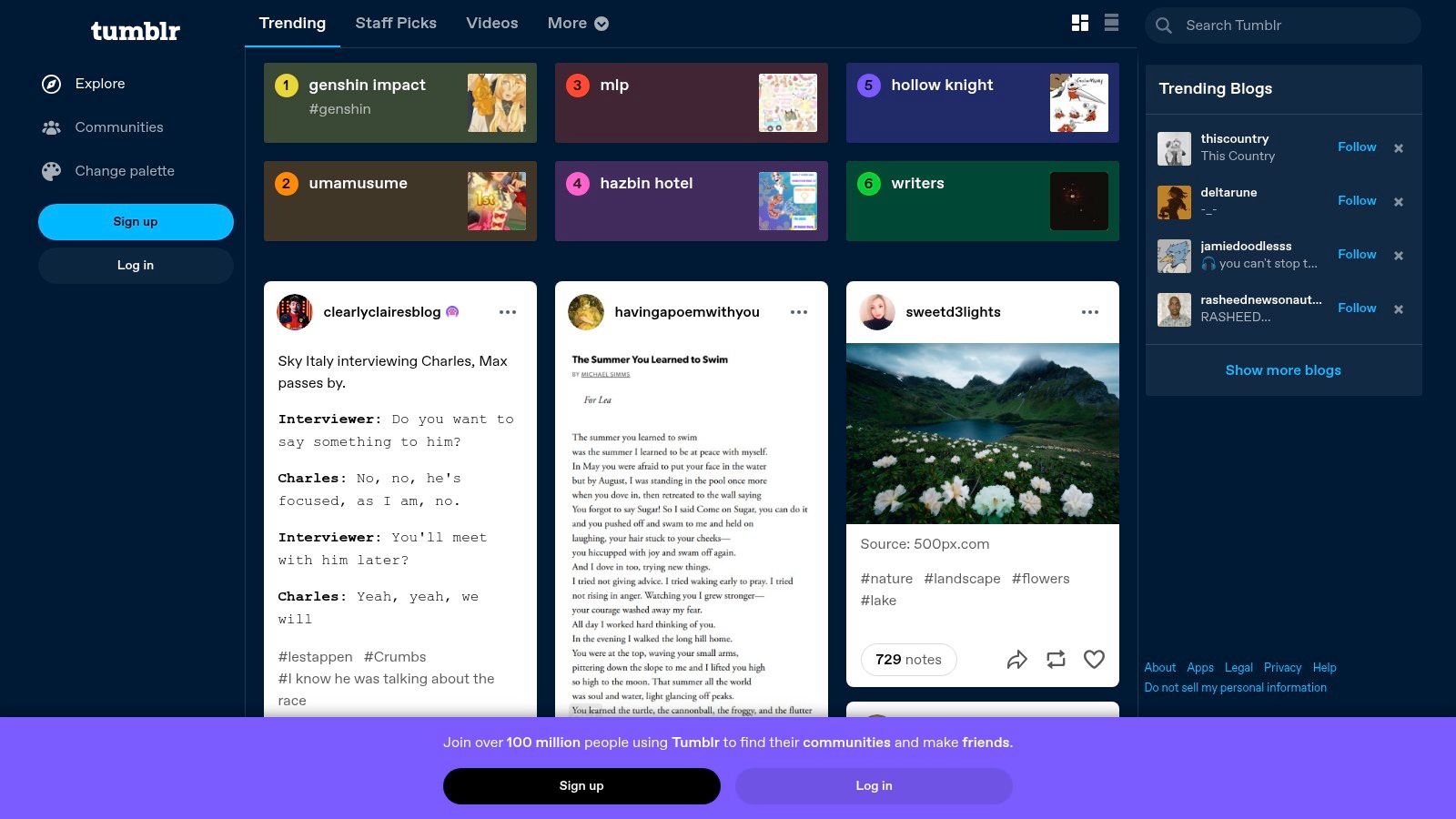
The platform's strength lies in its community-driven discovery engine. Unlike more isolated blogging platforms, Tumblr encourages interaction and content sharing, making it ideal for visual artists, fandom communities, and creators who thrive on multimedia. If your goal is to quickly build a following around a specific interest or aesthetic without worrying about hosting or technical setup, Tumblr offers a dynamic and engaging environment. It is a fantastic choice for casual and creative bloggers who prioritize community over monetization.
Key Details & Limitations
Best For: Visual bloggers, artists, hobbyists, and anyone focused on building a community around shared interests.
User Experience: The dashboard is intuitive and mobile-friendly, making it simple to post various media formats and interact with other blogs.
Pros: Strong social discovery features, excellent for multimedia content, and completely free to start and use.
Cons: Limited tools for long-form writing and professional branding, and ads are present unless you purchase a premium subscription.
Website: https://www.tumblr.com
8. Hashnode
Hashnode is a developer-centric blogging platform designed for the tech community, offering an exceptionally generous free tier. It empowers developers, engineers, and tech writers to share their knowledge on a platform that handles hosting, security, and optimization, allowing them to focus entirely on their content. The free plan is a standout among blogging sites for free, providing a custom domain at no cost, which is a rare and valuable feature for building a personal brand from day one.
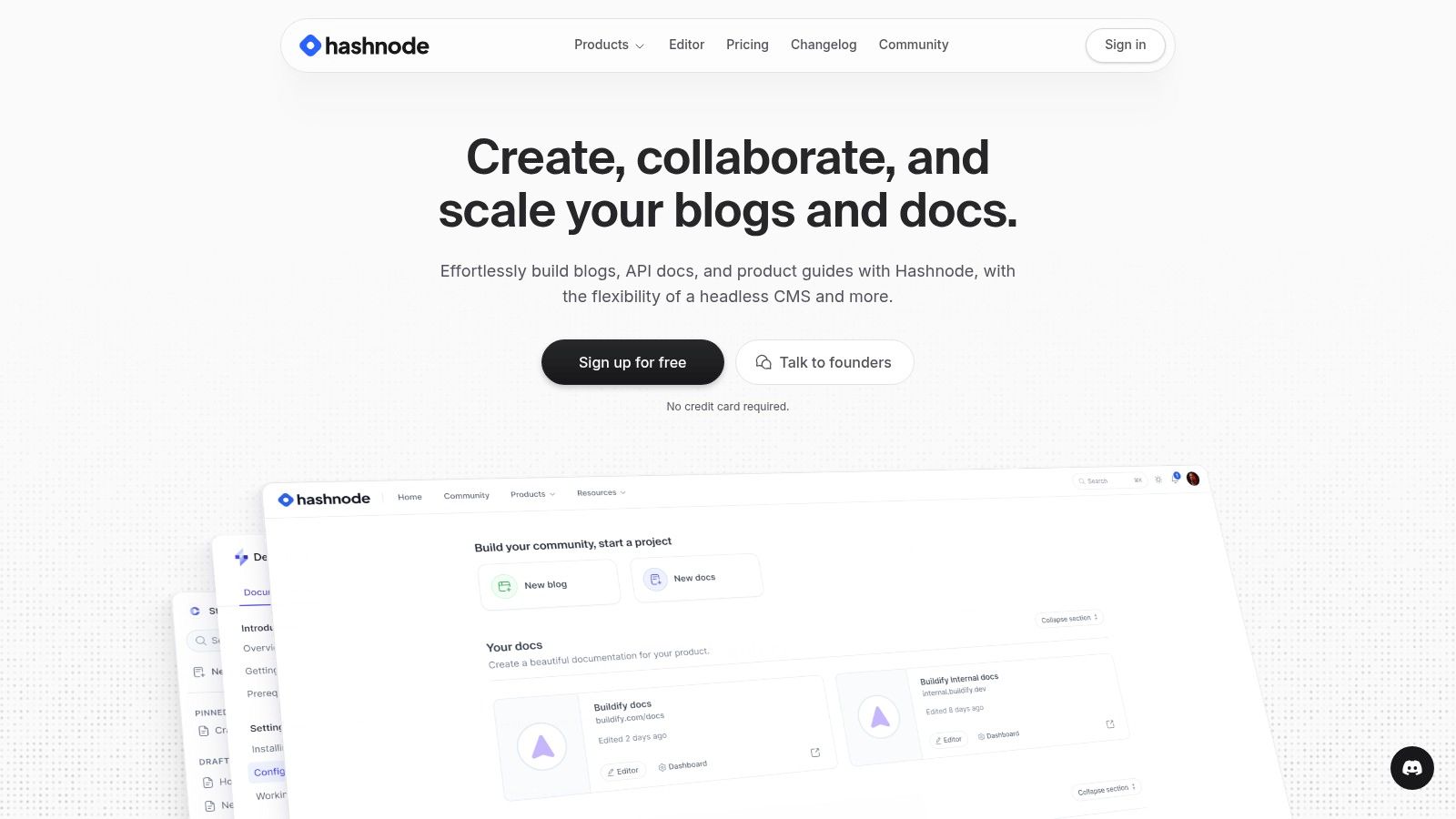
The platform stands out by automatically pushing articles to its built-in community of developers, giving new posts an immediate audience. Users can write in a clean WYSIWYG editor or use MDX for more complex formatting. It also includes AI-assisted writing tools to help generate ideas and refine drafts. While its niche focus is a strength, those looking for insights into Hashnode's broader applications can explore various case studies.
Key Details & Limitations
Best For: Software developers, data scientists, and tech professionals looking to build a personal brand and connect with a like-minded community.
User Experience: The interface is clean and minimalist, offering both a simple editor and powerful MDX support for technical content.
Pros: Completely free custom domain mapping, a built-in audience of tech enthusiasts, and no platform ads on your blog.
Cons: The platform's audience and features are heavily optimized for technical content, making it less suitable for lifestyle, travel, or general-interest blogs.
Website: https://hashnode.com
9. DEV Community (dev.to)
For software developers looking to share their knowledge, DEV Community is one of the best niche blogging sites for free. It’s a dedicated publishing platform built by and for developers, offering a streamlined experience focused entirely on technical content. Instead of worrying about hosting or design, you can write in a clean Markdown editor and publish directly to a highly engaged, built-in audience of programmers, engineers, and tech enthusiasts.
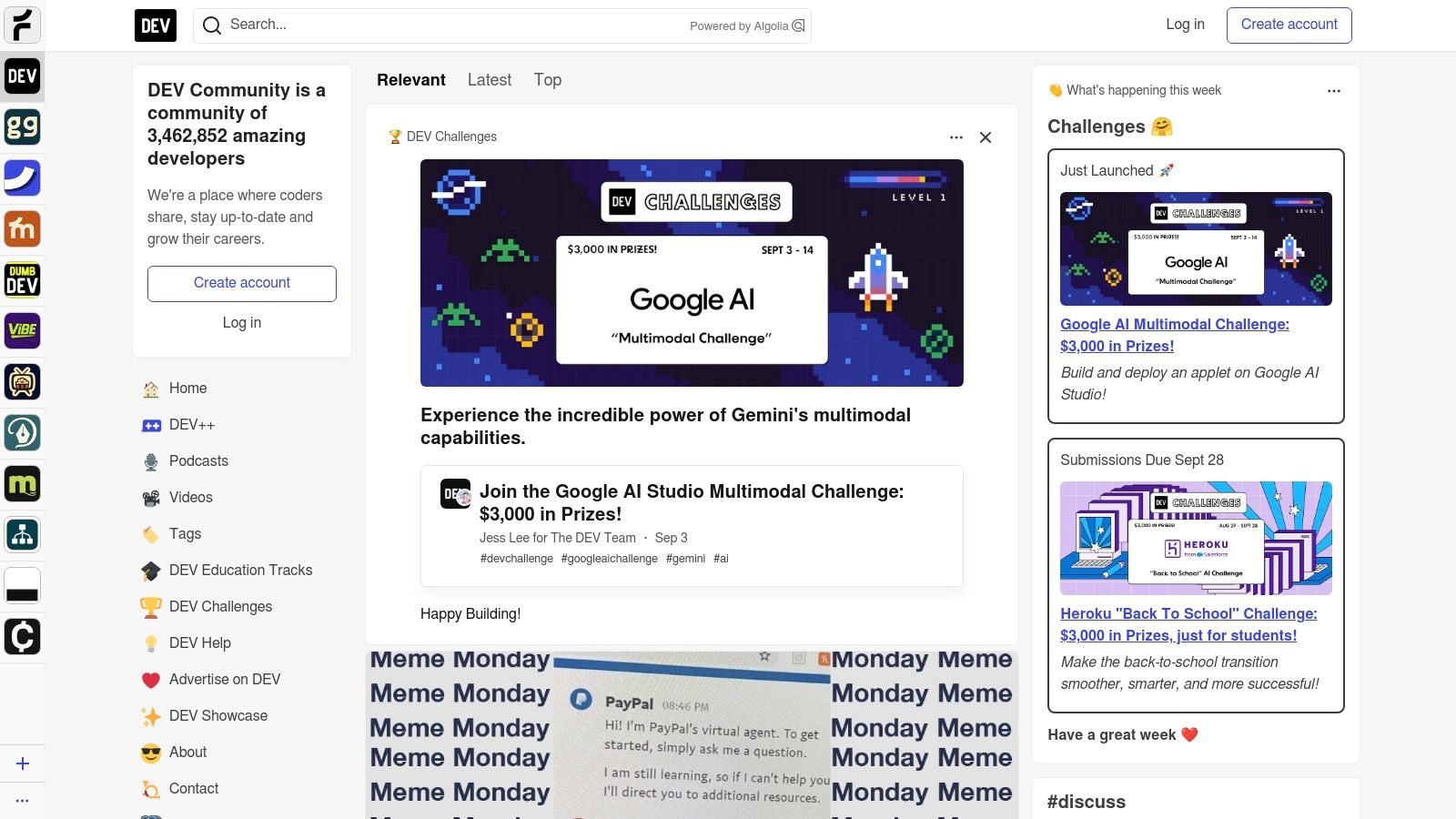
The platform’s standout feature is its support for the developer community and its SEO-friendly approach. It allows you to set canonical URLs, which means you can cross-post content from your personal blog to DEV Community to gain more visibility without being penalized by search engines for duplicate content. This makes it an incredible tool for amplifying your technical articles, tutorials, and stories while building a professional reputation in the software development world.
Key Details & Limitations
Best For: Software developers, engineers, and tech writers who want to reach a targeted technical audience.
User Experience: The Markdown-based editor is simple and familiar to developers, making content creation fast and efficient.
Pros: Access to a large, built-in developer audience, excellent for networking, and strong SEO benefits for cross-posting.
Cons: Highly niche focus makes it unsuitable for non-technical topics, and there is virtually no control over site design or branding.
Website: https://dev.to
10. GitHub Pages (with Jekyll)
GitHub Pages offers a unique and powerful way to launch a blog, especially for developers or those comfortable with a bit of code. Instead of a traditional CMS, it provides free static site hosting directly from your GitHub repository. By combining it with a static site generator like Jekyll, you can create a fast, secure, and completely free blog using simple Markdown files for your posts. This approach gives you total control over your content and site structure through version control.
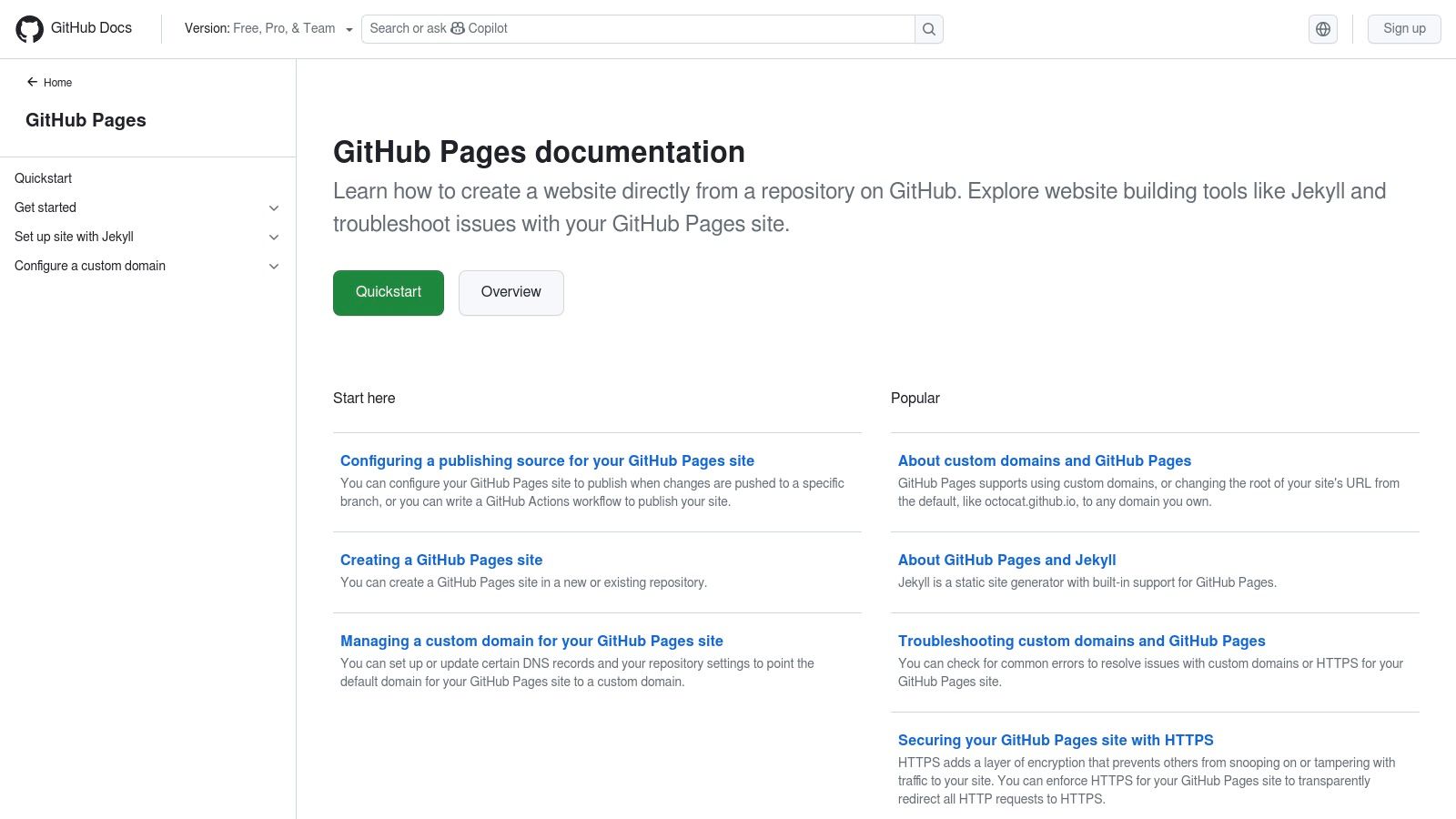
The platform stands out because it treats your blog as a code project. Every change is a commit, creating a full history of your site that can be reverted at any time. While it lacks a visual editor, the performance benefits of a static site are significant, offering lightning-fast load times for readers. For technical writers and programmers looking for blogging sites for free that integrate seamlessly into their existing workflow, GitHub Pages is an unmatched option.
Key Details & Limitations
Best For: Developers, technical writers, and users comfortable with Git, Markdown, and the command line.
User Experience: The workflow is code-centric. You write posts in a text editor, push changes via Git, and GitHub builds and deploys your site automatically.
Pros: Completely free with no ads, extremely fast performance, and version control for all content.
Cons: Steep learning curve for non-technical users, no built-in visual editor, and requires setup via command line.
Website: https://pages.github.com
11. Google Sites
Google Sites offers an incredibly simple and completely free way to build a web presence, integrated directly into your existing Google account. While not a traditional blogging platform, it functions as an excellent, no-cost option for creating a simple blog-like page, a personal portfolio, or a knowledge-sharing hub. It uses a drag-and-drop editor that makes page creation effortless, allowing you to embed content directly from Google Drive, YouTube, and Google Calendar.
The platform stands out for its absolute simplicity and reliability. There are no hosting costs, no software to install, and you get a free SSL certificate automatically. It’s one of the most accessible blogging sites for free if your goal is to publish information quickly without worrying about technical details. For a simple, static blog where you manually add new entries as pages or sections, Google Sites is a surprisingly effective and reliable choice.
Key Details & Limitations
Best For: Educators, students, and users needing a simple, low-maintenance site for sharing information or creating a basic portfolio.
User Experience: Extremely intuitive drag-and-drop interface, making it one of the easiest site builders to learn.
Pros: Absolutely free with no hidden costs, seamless integration with Google’s ecosystem, and reliable Google hosting.
Cons: Lacks dedicated blogging features like RSS feeds, post categories, or a native commenting system. Design customization is very limited.
Website: https://sites.google.com
12. Ghost (open source + optional hosting)
Ghost is a powerful open-source platform designed for professional publishers who want complete control over their content and brand. Unlike most traditional blogging sites for free, Ghost is available as free software that you can install and run on your own server. This self-hosting option gives you full ownership of your data, design, and monetization strategy, eliminating platform restrictions entirely.
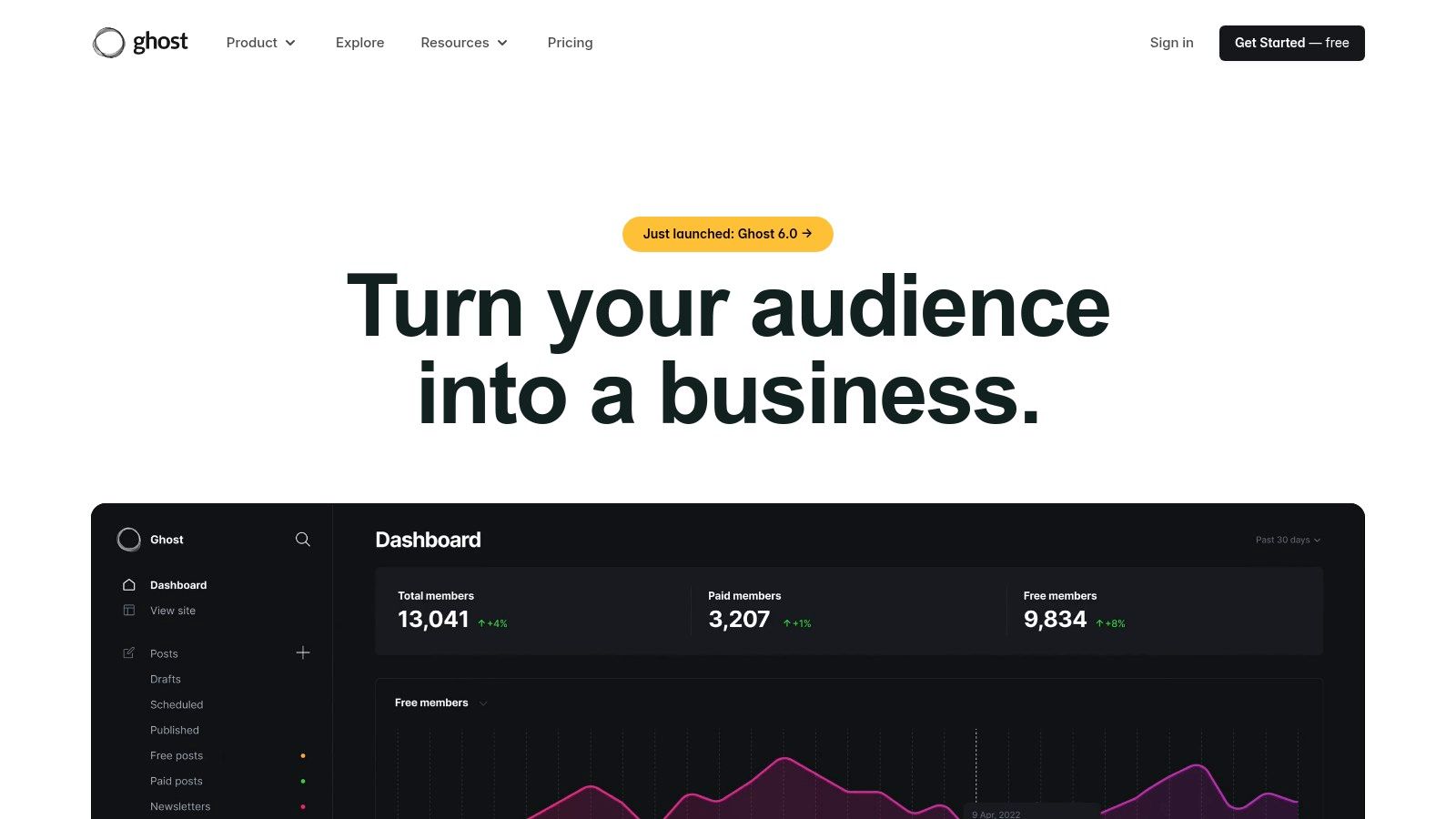
The platform truly shines with its modern, minimalist editor and built-in membership and newsletter features, making it ideal for creators building a direct relationship with their audience. While the software itself is free, it requires technical expertise to set up and maintain. For those who want the power without the hassle, Ghost also offers a premium managed hosting service called Ghost(Pro), which handles all the technical aspects for a monthly fee. This dual-option approach makes it a uniquely flexible choice.
Key Details & Limitations
Best For: Technically skilled bloggers, professional writers, and creators who want to build a membership or newsletter business.
User Experience: The editor is clean, fast, and uses a Markdown-based card system that is a joy to write with, focusing purely on content creation.
Pros: Complete ownership and control with self-hosting, built-in monetization tools, and superior performance and speed.
Cons: The free version requires you to have your own web hosting and the technical knowledge to install and manage the software; managed hosting is not free.
Website: https://ghost.org
Top 12 Free Blogging Sites Comparison
Platform | Core Features / Highlights | User Experience / Quality ★ | Value Proposition 💰 | Target Audience 👥 | Unique Selling Points ✨ | Price Points 💰 |
|---|---|---|---|---|---|---|
WordPress.com | Free hosting, SSL, huge theme/plugin library | ★★★★☆ Reliable, secure, huge community | Free plan w/ ads, paid removes ads | Casual to advanced bloggers | Extensive ecosystem, easy upgrade | Free; Paid plans from $4/mo |
Blogger (Blogspot) | Free hosting, Google integration | ★★★☆☆ Simple, reliable, minimal maintenance | Completely free, no traffic limits | Beginners, casual bloggers | Easy setup, Google service integration | Free |
Wix | Drag-and-drop, AI blog creation, SEO tools | ★★★★☆ User-friendly, modern design | Free with branding, paid for domain | Non-coders, marketers | AI-assisted content, marketing tools | Free; Paid plans from $14/mo |
Weebly (by Square) | Drag-and-drop, SSL, basic SEO | ★★★☆☆ Beginner-friendly, easy to learn | Low-cost upgrades, ecommerce ready | Small business, casual bloggers | Affordable upgrades, ecommerce potential | Free; Paid plans from $6/mo |
Medium | Writing-focused, clean reading experience | ★★★★☆ Distraction-free, built-in audience | Free to write, Partner program to earn | Writers, storytellers | Built-in content discovery, Partner payouts | Free; Membership $5/mo optional |
Substack | Newsletter + blog, monetization tools | ★★★★☆ Direct inbox delivery, simple setup | Free to publish, optional paid subs | Newsletter creators, monetizers | Integrated monetization + email delivery | Free; Subscriptions vary |
Tumblr | Social-style blogging, multimedia posts | ★★★☆☆ Social engagement, multimedia support | Free to start, premium for ad-free | Casual, multimedia bloggers | Strong social discovery & reblogging | Free; Premium $5/mo |
Hashnode | Developer-focused, AI writing tools, custom domain | ★★★★☆ Tech community, AI-assisted writing | Free custom domain, strong tech audience | Developers, tech bloggers | Free custom domain, developer community | Free |
DEV Community (dev.to) | Markdown editor, SEO-friendly, post scheduling | ★★★★☆ Developer engagement, SEO tools | Completely free | Software developers | SEO-friendly canonical URLs, open community | Free |
GitHub Pages (Jekyll) | Free static hosting, Jekyll integration | ★★★★☆ Fast, no recurring costs | Free hosting, ideal for technical users | Developers, tech-savvy users | Version control, static site performance | Free |
Google Sites | Simple drag-and-drop, Google Drive integration | ★★★☆☆ Ultra-simple, reliable | Free hosting, no blogging features | Beginners, knowledge sharing | Google ecosystem integration | Free |
Ghost (open source) | Open-source, membership, newsletters | ★★★★☆ Fast, smooth monetization | Free self-host or paid managed hosting | Serious bloggers, businesses | Full control, membership & newsletter focus | Free self-host; Paid from $11/mo |
Choosing Your Platform and Launching Your Blog
We've explored a comprehensive landscape of the best blogging sites for free, from powerful all-rounders to niche community platforms. The journey from aspiring writer to established blogger starts with a single, crucial decision: choosing the right foundation for your digital home. The perfect platform isn't a one-size-fits-all solution; it's a strategic choice that aligns directly with your long-term vision and immediate needs.
Distilling Your Decision: Key Takeaways
Recapping our deep dive, several core themes emerge. For ultimate scalability and a clear path toward professional growth, WordPress.com stands out, offering a free starting point with the potential to evolve into a fully customized, self-hosted powerhouse. If your goal is pure, uncomplicated content creation with seamless Google integration, Blogger remains a steadfast and reliable option.
For visually driven creators, particularly those in the gaming or influencer space, the intuitive drag-and-drop builders of Wix and Weebly provide an accessible way to create stunning, portfolio-style blogs without touching a line of code. Meanwhile, writers focused on building a dedicated readership and monetizing through subscriptions will find Substack’s model incredibly empowering, removing technical barriers to earning from your work.
Matching the Platform to Your Purpose
Your "why" is the most important factor. Before you click "sign up," take a moment to define your primary objective:
For the Hobbyist & Personal Storyteller: Platforms like Blogger, Tumblr, or Medium offer simplicity and a built-in social element, perfect for sharing your thoughts, gaming adventures, or personal journey without the overhead of technical management.
For the Aspiring Professional & Business Builder: WordPress.com is the clear frontrunner. Starting here allows you to learn a valuable content management system (CMS) and provides a direct upgrade path to a professional website as your brand or business grows.
For the Developer & Tech Writer: Hashnode, DEV Community, and GitHub Pages are purpose-built for you. They offer Markdown support, code syntax highlighting, and a built-in audience of peers eager to engage with technical content.
For the Monetization-Focused Creator: Substack is designed for direct monetization through newsletters. For gaming influencers looking to build an audience and share strategies, this can be a direct line to creating a sustainable income from your expertise.
Once you have your content online, getting it in front of the right audience is the next critical step. Visual platforms can be a massive traffic driver, so it’s wise to learn how to advertise your blog on Pinterest to tap into a new stream of engaged readers.
Ultimately, the best free blogging platform is the one you actually use. Don't get lost in analysis paralysis. Choose the tool that feels most intuitive and empowering for your specific goals, create your account, and publish that first post. The most successful blogs began with a single step, and yours is waiting to be taken.
Ready to turn your gaming passion into a profitable venture? A blog is your home base, and GameLoot Lab provides the roadmap. Discover elite strategies for monetizing your gameplay, from affiliate marketing to content creation, and use your new blog to build a powerful brand. Visit GameLoot Lab to unlock your earning potential today.
Comments